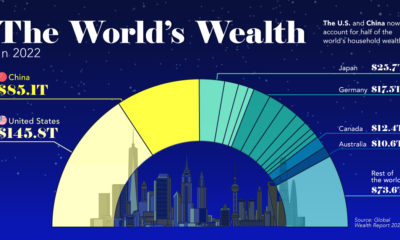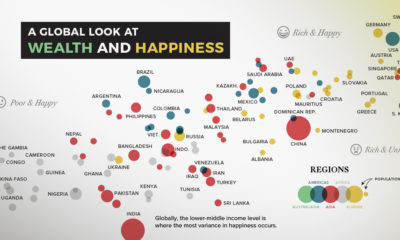The gist of it is: by working hard outside the traditional hours of a 9-to-5, a side hustle allows you to build a business around what you are truly passionate about. And if that endeavor is successful, it can also help you make the full transition into permanent entrepreneurship later on.
Enter the Side Hustle Economy
Today’s practical infographic from Quid Corner highlights 25 different ways to dip your toes into the side hustle economy.
Some of these side hustles, like building courses or writing eBooks on your area of expertise, are great ways to begin building your personal thought leadership brand. Meanwhile, other hustles listed here are more appropriate for supplementing your regular income. Getting extra cash in your pocket – and on your own terms – can help give you the confidence to start a business, or invest in further education.
Going From 0 to 60
If you are ready to make the dive into entrepreneurship, we previously posted 5 Ideas for Online Businesses in 2017. If you’re still just getting your feet wet, it’s side hustle time. Work on the side for additional capital, get a proof-of-concept for your idea, or find ways to build your personal brand. – Gary Vaynerchuk, Serial Entrepreneur Side hustling allows you to get a start while still having two feet on the ground. However, that’s not to say that side hustling is easy – it takes lot of work and commitment, and you have to be prepared to spend evenings and weekends to pursue your passion, with no guarantee for immediate results. Here’s a few other infographic resources to help you get started or motivated:
Why Businesses Fail The Habits of Highly Successful Entrepreneurs 31 Quotes on How to Launch a Startup 20 Reasons Why Startups Fail What Can We Learn From the Desks of Elon Musk and Mark Zuckerberg?
Good luck out there.
on Even while political regimes across these countries have changed over time, they’ve largely followed a few different types of governance. Today, every country can ultimately be classified into just nine broad forms of government systems. This map by Truman Du uses information from Wikipedia to map the government systems that rule the world today.
Countries By Type of Government
It’s important to note that this map charts government systems according to each country’s legal framework. Many countries have constitutions stating their de jure or legally recognized system of government, but their de facto or realized form of governance may be quite different. Here is a list of the stated government system of UN member states and observers as of January 2023: Let’s take a closer look at some of these systems.
Monarchies
Brought back into the spotlight after the death of Queen Elizabeth II of England in September 2022, this form of government has a single ruler. They carry titles from king and queen to sultan or emperor, and their government systems can be further divided into three modern types: constitutional, semi-constitutional, and absolute. A constitutional monarchy sees the monarch act as head of state within the parameters of a constitution, giving them little to no real power. For example, King Charles III is the head of 15 Commonwealth nations including Canada and Australia. However, each has their own head of government. On the other hand, a semi-constitutional monarchy lets the monarch or ruling royal family retain substantial political powers, as is the case in Jordan and Morocco. However, their monarchs still rule the country according to a democratic constitution and in concert with other institutions. Finally, an absolute monarchy is most like the monarchies of old, where the ruler has full power over governance, with modern examples including Saudi Arabia and Vatican City.
Republics
Unlike monarchies, the people hold the power in a republic government system, directly electing representatives to form government. Again, there are multiple types of modern republic governments: presidential, semi-presidential, and parliamentary. The presidential republic could be considered a direct progression from monarchies. This system has a strong and independent chief executive with extensive powers when it comes to domestic affairs and foreign policy. An example of this is the United States, where the President is both the head of state and the head of government. In a semi-presidential republic, the president is the head of state and has some executive powers that are independent of the legislature. However, the prime minister (or chancellor or equivalent title) is the head of government, responsible to the legislature along with the cabinet. Russia is a classic example of this type of government. The last type of republic system is parliamentary. In this system, the president is a figurehead, while the head of government holds real power and is validated by and accountable to the parliament. This type of system can be seen in Germany, Italy, and India and is akin to constitutional monarchies. It’s also important to point out that some parliamentary republic systems operate slightly differently. For example in South Africa, the president is both the head of state and government, but is elected directly by the legislature. This leaves them (and their ministries) potentially subject to parliamentary confidence.
One-Party State
Many of the systems above involve multiple political parties vying to rule and govern their respective countries. In a one-party state, also called a single-party state or single-party system, only one political party has the right to form government. All other political parties are either outlawed or only allowed limited participation in elections. In this system, a country’s head of state and head of government can be executive or ceremonial but political power is constitutionally linked to a single political movement. China is the most well-known example of this government system, with the General Secretary of the Communist Party of China ruling as the de facto leader since 1989.
Provisional
The final form of government is a provisional government formed as an interim or transitional government. In this system, an emergency governmental body is created to manage political transitions after the collapse of a government, or when a new state is formed. Often these evolve into fully constitutionalized systems, but sometimes they hold power for longer than expected. Some examples of countries that are considered provisional include Libya, Burkina Faso, and Chad.

















